Determinants of Indigenous Health: A Media Article Analysis
VerifiedAdded on 2020/05/11
|15
|4076
|148
Report
AI Summary
This report examines the determinants of Indigenous health in Australia through an analysis of four media articles. The report highlights key issues such as racism in healthcare, housing shortages and their impact on scabies outbreaks, and the challenges of menstrual hygiene in remote communities. The analysis explores how these factors contribute to health inequalities among Indigenous Australians, emphasizing the role of social determinants like housing, sanitation, and access to healthcare. The report connects these issues with relevant models and approaches, discussing the limitations of current interventions and the need for systemic change to address the root causes of health disparities. The articles also highlight the need for culturally safe healthcare, improved housing, and better access to hygiene products. This report provides a comprehensive overview of the issues, offering insights into the complex factors affecting Indigenous health and the potential for positive change.

Running head: DETERMINANTS OF INDEGENOUS HEALTH
DETERMINANTS OF INDEGENOUS HEALTH
Name of the Student
Name of the university
Author’s note
DETERMINANTS OF INDEGENOUS HEALTH
Name of the Student
Name of the university
Author’s note
Paraphrase This Document
Need a fresh take? Get an instant paraphrase of this document with our AI Paraphraser

1DETERMINANTS OF INDEGENOUS HEALTH
Introduction
There exists a disparity in health among the Indigenous non-Indigenous Australians
which has been under constant highlight by the Australian media. The mass media campaigns
previously were majorly focused on the raising awareness among the people while overlooking
the negative social determinants of health. However, recent findings show that there are several
social determinants that have lead to the generation of health inequality among the Australian
aboriginals like of proper hygiene, racism, discrimination and abundance of infectious diseases.
Indigenous health outcomes are influenced by a broad range of social determinants including
housing, employment, incarceration, racism, education and discrimination, and can be attributed
to the impact of colonization (Taylor & Guerin, 2014). This report will analyze four significant
media articles that are focused on housing and living conditions in remote Indigenous
communities of Australia. The report will also try to evaluate how these factors are proving to be
an important social determinant among the indigenous people.
The report sheds light over racism, lack of proper sanitation, overcrowding and spreading
of contagious disease and prevalence of high smoking rates and their negative effects on the
living condition of the indigenous people in Australia and thus generating health inequalities.
Media: Article One
A new policy statement on racism in the health system has been released by the Australian
Indigenous Doctors Association (Australia, 2016)
https://ajp.com.au/news/racism-impacts-health-care/
Introduction
There exists a disparity in health among the Indigenous non-Indigenous Australians
which has been under constant highlight by the Australian media. The mass media campaigns
previously were majorly focused on the raising awareness among the people while overlooking
the negative social determinants of health. However, recent findings show that there are several
social determinants that have lead to the generation of health inequality among the Australian
aboriginals like of proper hygiene, racism, discrimination and abundance of infectious diseases.
Indigenous health outcomes are influenced by a broad range of social determinants including
housing, employment, incarceration, racism, education and discrimination, and can be attributed
to the impact of colonization (Taylor & Guerin, 2014). This report will analyze four significant
media articles that are focused on housing and living conditions in remote Indigenous
communities of Australia. The report will also try to evaluate how these factors are proving to be
an important social determinant among the indigenous people.
The report sheds light over racism, lack of proper sanitation, overcrowding and spreading
of contagious disease and prevalence of high smoking rates and their negative effects on the
living condition of the indigenous people in Australia and thus generating health inequalities.
Media: Article One
A new policy statement on racism in the health system has been released by the Australian
Indigenous Doctors Association (Australia, 2016)
https://ajp.com.au/news/racism-impacts-health-care/
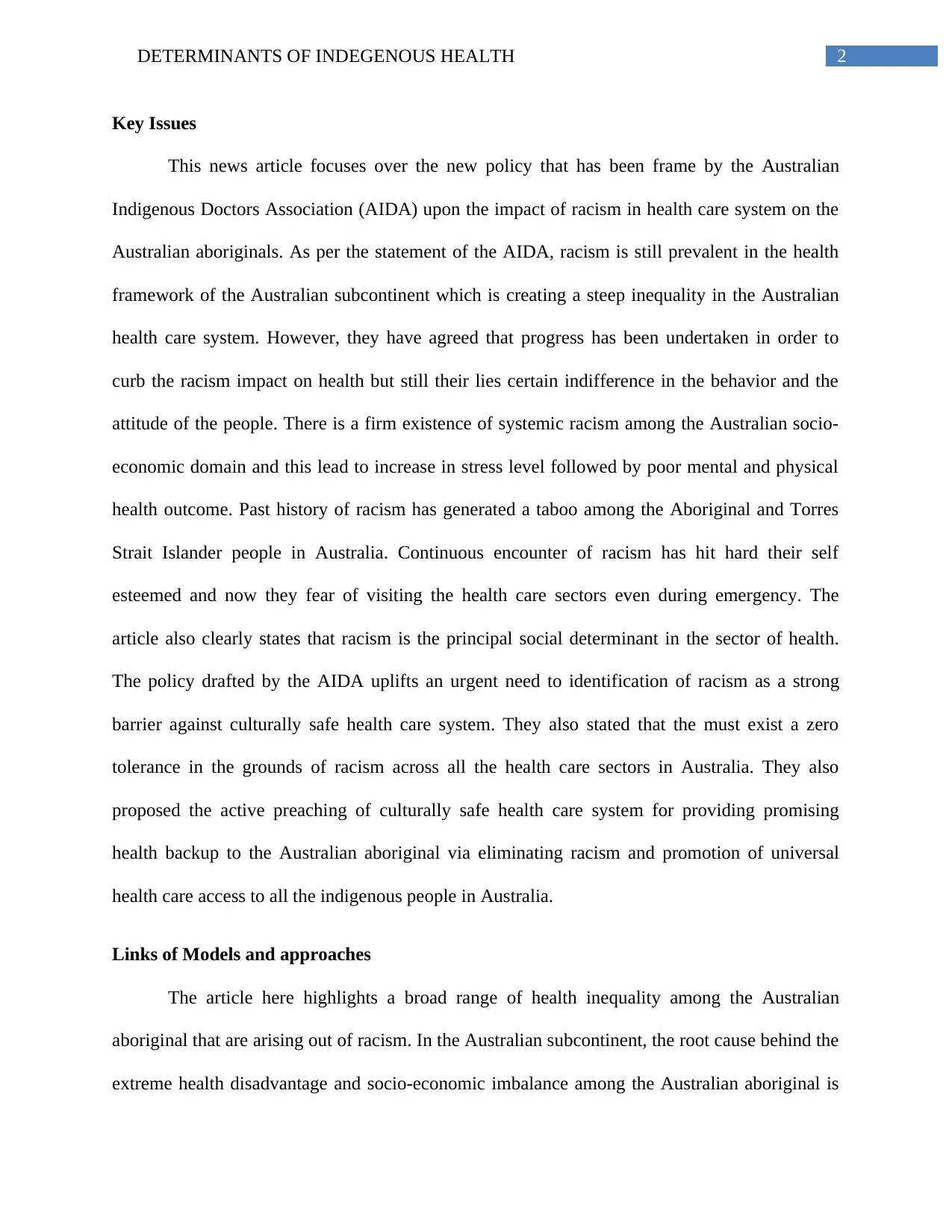
2DETERMINANTS OF INDEGENOUS HEALTH
Key Issues
This news article focuses over the new policy that has been frame by the Australian
Indigenous Doctors Association (AIDA) upon the impact of racism in health care system on the
Australian aboriginals. As per the statement of the AIDA, racism is still prevalent in the health
framework of the Australian subcontinent which is creating a steep inequality in the Australian
health care system. However, they have agreed that progress has been undertaken in order to
curb the racism impact on health but still their lies certain indifference in the behavior and the
attitude of the people. There is a firm existence of systemic racism among the Australian socio-
economic domain and this lead to increase in stress level followed by poor mental and physical
health outcome. Past history of racism has generated a taboo among the Aboriginal and Torres
Strait Islander people in Australia. Continuous encounter of racism has hit hard their self
esteemed and now they fear of visiting the health care sectors even during emergency. The
article also clearly states that racism is the principal social determinant in the sector of health.
The policy drafted by the AIDA uplifts an urgent need to identification of racism as a strong
barrier against culturally safe health care system. They also stated that the must exist a zero
tolerance in the grounds of racism across all the health care sectors in Australia. They also
proposed the active preaching of culturally safe health care system for providing promising
health backup to the Australian aboriginal via eliminating racism and promotion of universal
health care access to all the indigenous people in Australia.
Links of Models and approaches
The article here highlights a broad range of health inequality among the Australian
aboriginal that are arising out of racism. In the Australian subcontinent, the root cause behind the
extreme health disadvantage and socio-economic imbalance among the Australian aboriginal is
Key Issues
This news article focuses over the new policy that has been frame by the Australian
Indigenous Doctors Association (AIDA) upon the impact of racism in health care system on the
Australian aboriginals. As per the statement of the AIDA, racism is still prevalent in the health
framework of the Australian subcontinent which is creating a steep inequality in the Australian
health care system. However, they have agreed that progress has been undertaken in order to
curb the racism impact on health but still their lies certain indifference in the behavior and the
attitude of the people. There is a firm existence of systemic racism among the Australian socio-
economic domain and this lead to increase in stress level followed by poor mental and physical
health outcome. Past history of racism has generated a taboo among the Aboriginal and Torres
Strait Islander people in Australia. Continuous encounter of racism has hit hard their self
esteemed and now they fear of visiting the health care sectors even during emergency. The
article also clearly states that racism is the principal social determinant in the sector of health.
The policy drafted by the AIDA uplifts an urgent need to identification of racism as a strong
barrier against culturally safe health care system. They also stated that the must exist a zero
tolerance in the grounds of racism across all the health care sectors in Australia. They also
proposed the active preaching of culturally safe health care system for providing promising
health backup to the Australian aboriginal via eliminating racism and promotion of universal
health care access to all the indigenous people in Australia.
Links of Models and approaches
The article here highlights a broad range of health inequality among the Australian
aboriginal that are arising out of racism. In the Australian subcontinent, the root cause behind the
extreme health disadvantage and socio-economic imbalance among the Australian aboriginal is
⊘ This is a preview!⊘
Do you want full access?
Subscribe today to unlock all pages.

Trusted by 1+ million students worldwide
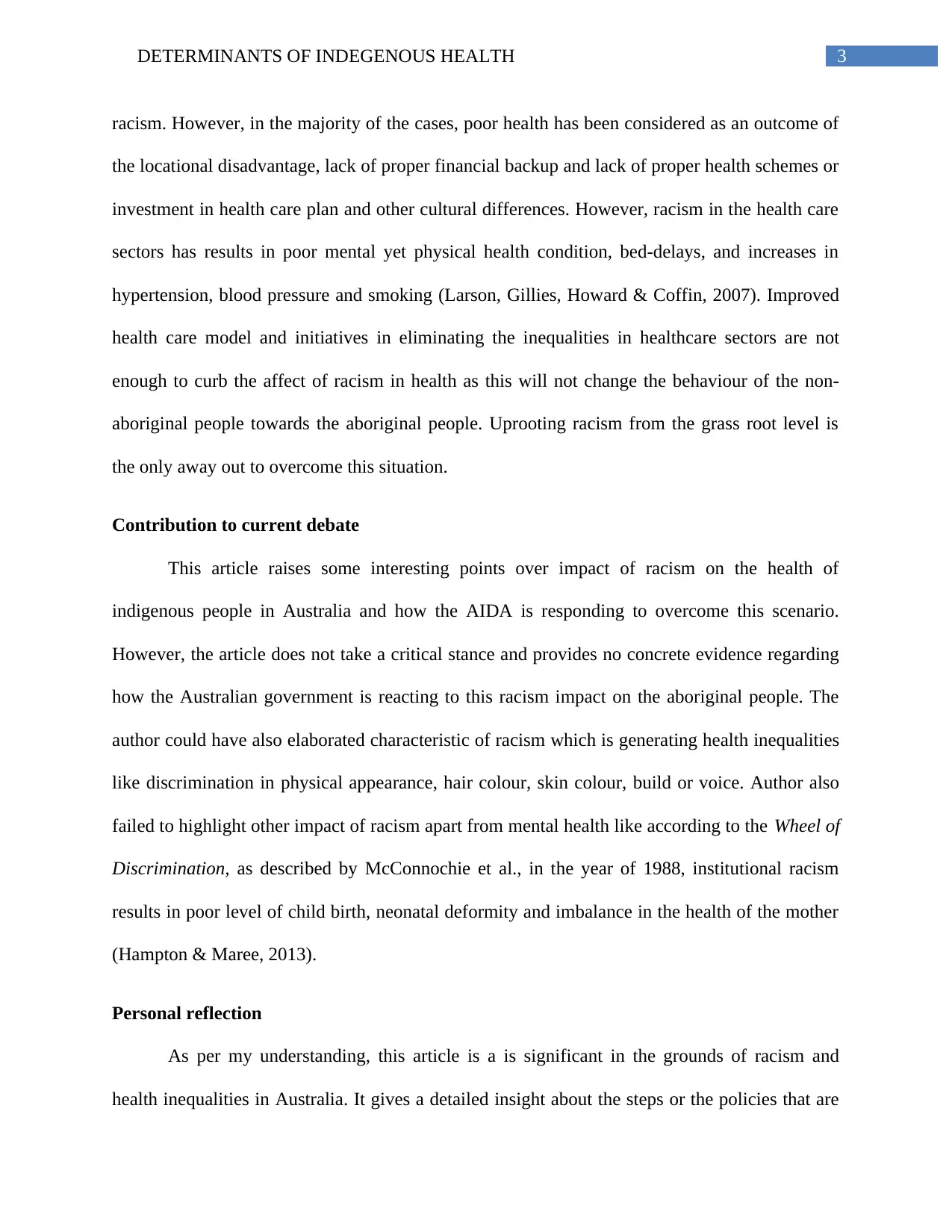
3DETERMINANTS OF INDEGENOUS HEALTH
racism. However, in the majority of the cases, poor health has been considered as an outcome of
the locational disadvantage, lack of proper financial backup and lack of proper health schemes or
investment in health care plan and other cultural differences. However, racism in the health care
sectors has results in poor mental yet physical health condition, bed-delays, and increases in
hypertension, blood pressure and smoking (Larson, Gillies, Howard & Coffin, 2007). Improved
health care model and initiatives in eliminating the inequalities in healthcare sectors are not
enough to curb the affect of racism in health as this will not change the behaviour of the non-
aboriginal people towards the aboriginal people. Uprooting racism from the grass root level is
the only away out to overcome this situation.
Contribution to current debate
This article raises some interesting points over impact of racism on the health of
indigenous people in Australia and how the AIDA is responding to overcome this scenario.
However, the article does not take a critical stance and provides no concrete evidence regarding
how the Australian government is reacting to this racism impact on the aboriginal people. The
author could have also elaborated characteristic of racism which is generating health inequalities
like discrimination in physical appearance, hair colour, skin colour, build or voice. Author also
failed to highlight other impact of racism apart from mental health like according to the Wheel of
Discrimination, as described by McConnochie et al., in the year of 1988, institutional racism
results in poor level of child birth, neonatal deformity and imbalance in the health of the mother
(Hampton & Maree, 2013).
Personal reflection
As per my understanding, this article is a is significant in the grounds of racism and
health inequalities in Australia. It gives a detailed insight about the steps or the policies that are
racism. However, in the majority of the cases, poor health has been considered as an outcome of
the locational disadvantage, lack of proper financial backup and lack of proper health schemes or
investment in health care plan and other cultural differences. However, racism in the health care
sectors has results in poor mental yet physical health condition, bed-delays, and increases in
hypertension, blood pressure and smoking (Larson, Gillies, Howard & Coffin, 2007). Improved
health care model and initiatives in eliminating the inequalities in healthcare sectors are not
enough to curb the affect of racism in health as this will not change the behaviour of the non-
aboriginal people towards the aboriginal people. Uprooting racism from the grass root level is
the only away out to overcome this situation.
Contribution to current debate
This article raises some interesting points over impact of racism on the health of
indigenous people in Australia and how the AIDA is responding to overcome this scenario.
However, the article does not take a critical stance and provides no concrete evidence regarding
how the Australian government is reacting to this racism impact on the aboriginal people. The
author could have also elaborated characteristic of racism which is generating health inequalities
like discrimination in physical appearance, hair colour, skin colour, build or voice. Author also
failed to highlight other impact of racism apart from mental health like according to the Wheel of
Discrimination, as described by McConnochie et al., in the year of 1988, institutional racism
results in poor level of child birth, neonatal deformity and imbalance in the health of the mother
(Hampton & Maree, 2013).
Personal reflection
As per my understanding, this article is a is significant in the grounds of racism and
health inequalities in Australia. It gives a detailed insight about the steps or the policies that are
Paraphrase This Document
Need a fresh take? Get an instant paraphrase of this document with our AI Paraphraser
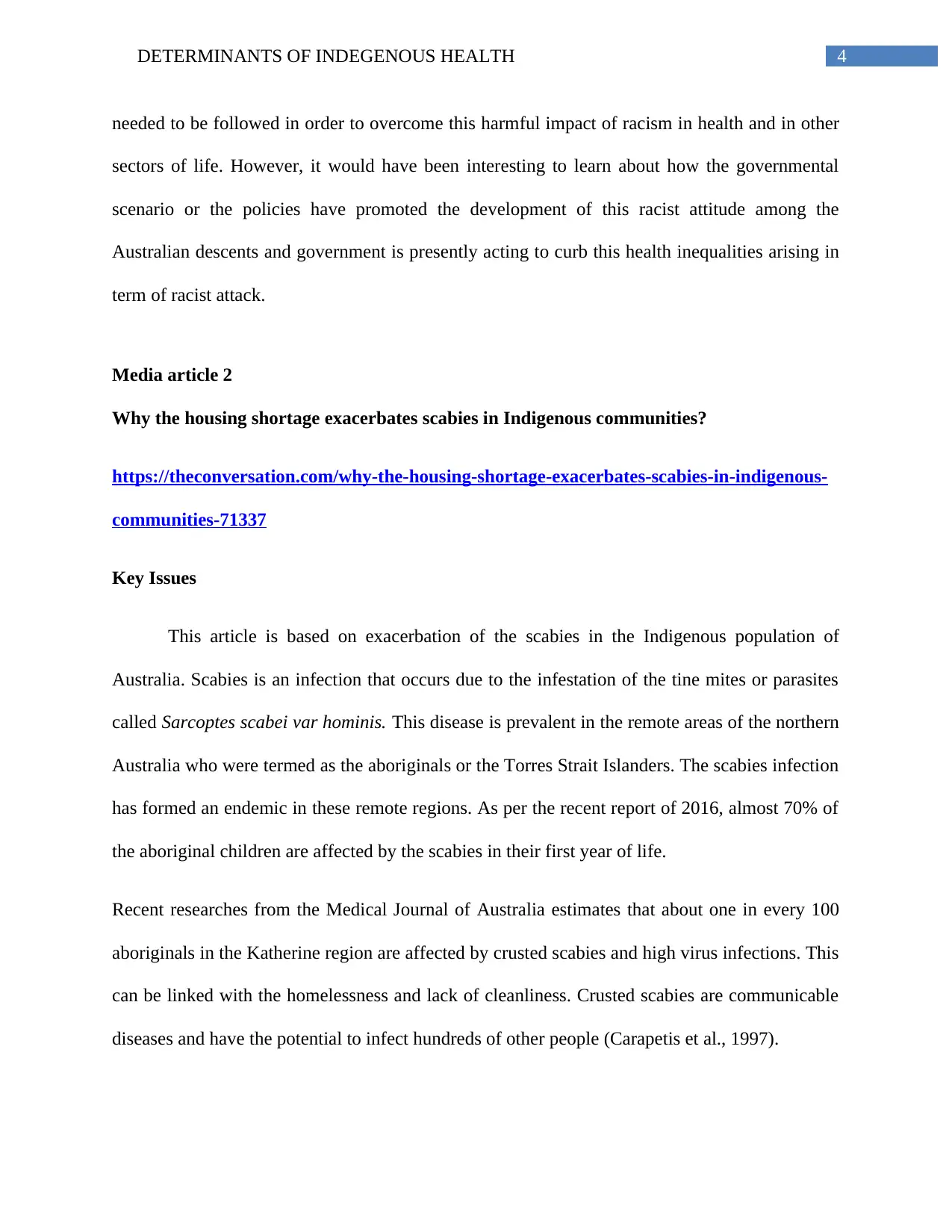
4DETERMINANTS OF INDEGENOUS HEALTH
needed to be followed in order to overcome this harmful impact of racism in health and in other
sectors of life. However, it would have been interesting to learn about how the governmental
scenario or the policies have promoted the development of this racist attitude among the
Australian descents and government is presently acting to curb this health inequalities arising in
term of racist attack.
Media article 2
Why the housing shortage exacerbates scabies in Indigenous communities?
https://theconversation.com/why-the-housing-shortage-exacerbates-scabies-in-indigenous-
communities-71337
Key Issues
This article is based on exacerbation of the scabies in the Indigenous population of
Australia. Scabies is an infection that occurs due to the infestation of the tine mites or parasites
called Sarcoptes scabei var hominis. This disease is prevalent in the remote areas of the northern
Australia who were termed as the aboriginals or the Torres Strait Islanders. The scabies infection
has formed an endemic in these remote regions. As per the recent report of 2016, almost 70% of
the aboriginal children are affected by the scabies in their first year of life.
Recent researches from the Medical Journal of Australia estimates that about one in every 100
aboriginals in the Katherine region are affected by crusted scabies and high virus infections. This
can be linked with the homelessness and lack of cleanliness. Crusted scabies are communicable
diseases and have the potential to infect hundreds of other people (Carapetis et al., 1997).
needed to be followed in order to overcome this harmful impact of racism in health and in other
sectors of life. However, it would have been interesting to learn about how the governmental
scenario or the policies have promoted the development of this racist attitude among the
Australian descents and government is presently acting to curb this health inequalities arising in
term of racist attack.
Media article 2
Why the housing shortage exacerbates scabies in Indigenous communities?
https://theconversation.com/why-the-housing-shortage-exacerbates-scabies-in-indigenous-
communities-71337
Key Issues
This article is based on exacerbation of the scabies in the Indigenous population of
Australia. Scabies is an infection that occurs due to the infestation of the tine mites or parasites
called Sarcoptes scabei var hominis. This disease is prevalent in the remote areas of the northern
Australia who were termed as the aboriginals or the Torres Strait Islanders. The scabies infection
has formed an endemic in these remote regions. As per the recent report of 2016, almost 70% of
the aboriginal children are affected by the scabies in their first year of life.
Recent researches from the Medical Journal of Australia estimates that about one in every 100
aboriginals in the Katherine region are affected by crusted scabies and high virus infections. This
can be linked with the homelessness and lack of cleanliness. Crusted scabies are communicable
diseases and have the potential to infect hundreds of other people (Carapetis et al., 1997).

5DETERMINANTS OF INDEGENOUS HEALTH
Crusted rabies had been identified in the list of the noted diseases in the Northern territory in the
year 2016 (Gibson et al., 2015).
The key issue of this news is that The chairman of The Northern Territory Department of Health
centre for disease control have said that considerable improvements are going on in the field of
improving the housing infrastructure and sanitation, although no improvements have been found
in the past few years in terms of health.
Links to models and approaches
This article provides with the information there health disparity lies among the
Indigenous and the non indigenous Australians. The Aboriginals do not get access to clean
infrastructure. According to the aboriginal fringe dwellers like Bennelong, many of the members
of the aboriginal community never had a safe home since they were being ousted from their land
by the white Australians (Gibson et al., 2015). And many aboriginals are still working on the
development of a proper home. Most of the aboriginals cannot afford private rental houses and
therefore have to depend on the private housing.
It is reported that a person having scabies can have thousands of mites present in the body. The
main reasons behind the spreading of scabies are prolonged physical contact, sharing a common
bed. All these can link to the lack of cleanliness and overcrowding of the population (Gibson et
al., 2015).
Contributing to Current debate
As per the news The Northern Territory Department of Health centre for disease control
is currently working in association to the “One disease”, which is a philanthropic organization.
Crusted rabies had been identified in the list of the noted diseases in the Northern territory in the
year 2016 (Gibson et al., 2015).
The key issue of this news is that The chairman of The Northern Territory Department of Health
centre for disease control have said that considerable improvements are going on in the field of
improving the housing infrastructure and sanitation, although no improvements have been found
in the past few years in terms of health.
Links to models and approaches
This article provides with the information there health disparity lies among the
Indigenous and the non indigenous Australians. The Aboriginals do not get access to clean
infrastructure. According to the aboriginal fringe dwellers like Bennelong, many of the members
of the aboriginal community never had a safe home since they were being ousted from their land
by the white Australians (Gibson et al., 2015). And many aboriginals are still working on the
development of a proper home. Most of the aboriginals cannot afford private rental houses and
therefore have to depend on the private housing.
It is reported that a person having scabies can have thousands of mites present in the body. The
main reasons behind the spreading of scabies are prolonged physical contact, sharing a common
bed. All these can link to the lack of cleanliness and overcrowding of the population (Gibson et
al., 2015).
Contributing to Current debate
As per the news The Northern Territory Department of Health centre for disease control
is currently working in association to the “One disease”, which is a philanthropic organization.
⊘ This is a preview!⊘
Do you want full access?
Subscribe today to unlock all pages.

Trusted by 1+ million students worldwide
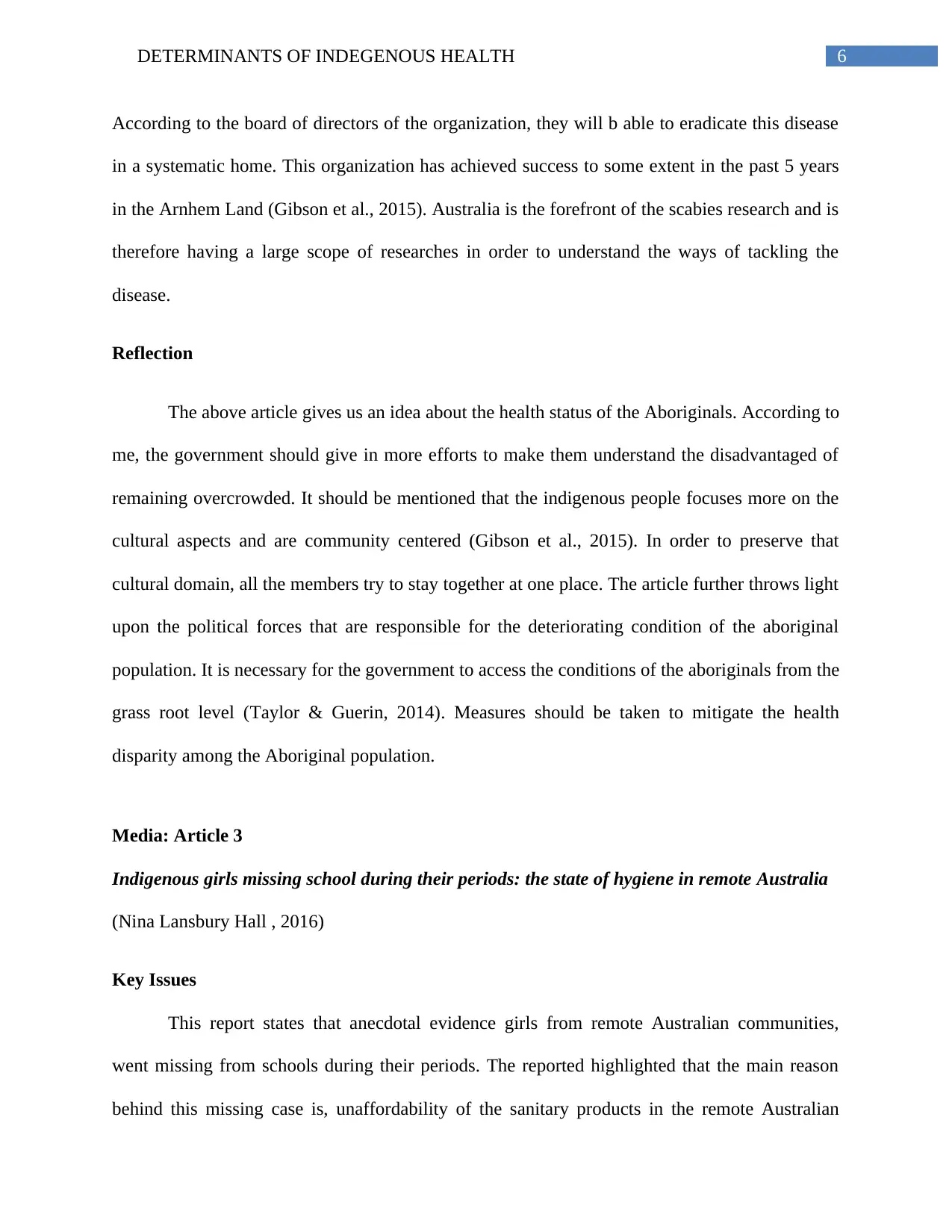
6DETERMINANTS OF INDEGENOUS HEALTH
According to the board of directors of the organization, they will b able to eradicate this disease
in a systematic home. This organization has achieved success to some extent in the past 5 years
in the Arnhem Land (Gibson et al., 2015). Australia is the forefront of the scabies research and is
therefore having a large scope of researches in order to understand the ways of tackling the
disease.
Reflection
The above article gives us an idea about the health status of the Aboriginals. According to
me, the government should give in more efforts to make them understand the disadvantaged of
remaining overcrowded. It should be mentioned that the indigenous people focuses more on the
cultural aspects and are community centered (Gibson et al., 2015). In order to preserve that
cultural domain, all the members try to stay together at one place. The article further throws light
upon the political forces that are responsible for the deteriorating condition of the aboriginal
population. It is necessary for the government to access the conditions of the aboriginals from the
grass root level (Taylor & Guerin, 2014). Measures should be taken to mitigate the health
disparity among the Aboriginal population.
Media: Article 3
Indigenous girls missing school during their periods: the state of hygiene in remote Australia
(Nina Lansbury Hall , 2016)
Key Issues
This report states that anecdotal evidence girls from remote Australian communities,
went missing from schools during their periods. The reported highlighted that the main reason
behind this missing case is, unaffordability of the sanitary products in the remote Australian
According to the board of directors of the organization, they will b able to eradicate this disease
in a systematic home. This organization has achieved success to some extent in the past 5 years
in the Arnhem Land (Gibson et al., 2015). Australia is the forefront of the scabies research and is
therefore having a large scope of researches in order to understand the ways of tackling the
disease.
Reflection
The above article gives us an idea about the health status of the Aboriginals. According to
me, the government should give in more efforts to make them understand the disadvantaged of
remaining overcrowded. It should be mentioned that the indigenous people focuses more on the
cultural aspects and are community centered (Gibson et al., 2015). In order to preserve that
cultural domain, all the members try to stay together at one place. The article further throws light
upon the political forces that are responsible for the deteriorating condition of the aboriginal
population. It is necessary for the government to access the conditions of the aboriginals from the
grass root level (Taylor & Guerin, 2014). Measures should be taken to mitigate the health
disparity among the Aboriginal population.
Media: Article 3
Indigenous girls missing school during their periods: the state of hygiene in remote Australia
(Nina Lansbury Hall , 2016)
Key Issues
This report states that anecdotal evidence girls from remote Australian communities,
went missing from schools during their periods. The reported highlighted that the main reason
behind this missing case is, unaffordability of the sanitary products in the remote Australian
Paraphrase This Document
Need a fresh take? Get an instant paraphrase of this document with our AI Paraphraser

7DETERMINANTS OF INDEGENOUS HEALTH
areas where the aboriginal resides. Women or girls here use toilet papers, rags and socks insteas
of sanitary packs due to hike in price. Moreover, even if the products are affordable, girls
members of the family are too shameful to visit the shop and but the sanitary products in front
any male members of the society. The under wear are also costly, keeping their financial
background into consideration. Even if the women make use of under wear, washing and drying
the underwear in public is consider shameful. Moreover not only due to the social taboos, there
also exists a huge dearth of proper hygiene in the schools of the remote areas of Australia. As per
the report, the school girls came up with the complain that the toilet of the school is devoid of
soap, dust bins and adequate supply of water, compelling them to stay indoors, generating a lack
of proper educational background among them. Moreover, the girls who are found visiting the
schools develop infectious disease. This report published coincided with the report published by
NAIDOC (National Aboriginal and Islander Day Observance Committee).
Links of Models and approaches
This article has rightly updated the correct approach of the health and hygiene condition
among the Australian Aboriginal children living in remote communities. There still lies a high
burden of infectious diseases among these aboriginal children due to existence of poor hygiene
and prevalence of unsanitary living conditions. However, apart from shame, article did not
highlight other social taboos that the prevalent among these aboriginals leading to the generation
of the infectious disease. The children here do not wash their hands, before and after their meal,
leading to the generation of diarrheal disease and infectious diseases. The article however,
rightly uplifted the need for adequate access of sanitary pads, water and washing facilities in
order to increases the attendance in school and to prevent generation of detrimental infectious
areas where the aboriginal resides. Women or girls here use toilet papers, rags and socks insteas
of sanitary packs due to hike in price. Moreover, even if the products are affordable, girls
members of the family are too shameful to visit the shop and but the sanitary products in front
any male members of the society. The under wear are also costly, keeping their financial
background into consideration. Even if the women make use of under wear, washing and drying
the underwear in public is consider shameful. Moreover not only due to the social taboos, there
also exists a huge dearth of proper hygiene in the schools of the remote areas of Australia. As per
the report, the school girls came up with the complain that the toilet of the school is devoid of
soap, dust bins and adequate supply of water, compelling them to stay indoors, generating a lack
of proper educational background among them. Moreover, the girls who are found visiting the
schools develop infectious disease. This report published coincided with the report published by
NAIDOC (National Aboriginal and Islander Day Observance Committee).
Links of Models and approaches
This article has rightly updated the correct approach of the health and hygiene condition
among the Australian Aboriginal children living in remote communities. There still lies a high
burden of infectious diseases among these aboriginal children due to existence of poor hygiene
and prevalence of unsanitary living conditions. However, apart from shame, article did not
highlight other social taboos that the prevalent among these aboriginals leading to the generation
of the infectious disease. The children here do not wash their hands, before and after their meal,
leading to the generation of diarrheal disease and infectious diseases. The article however,
rightly uplifted the need for adequate access of sanitary pads, water and washing facilities in
order to increases the attendance in school and to prevent generation of detrimental infectious
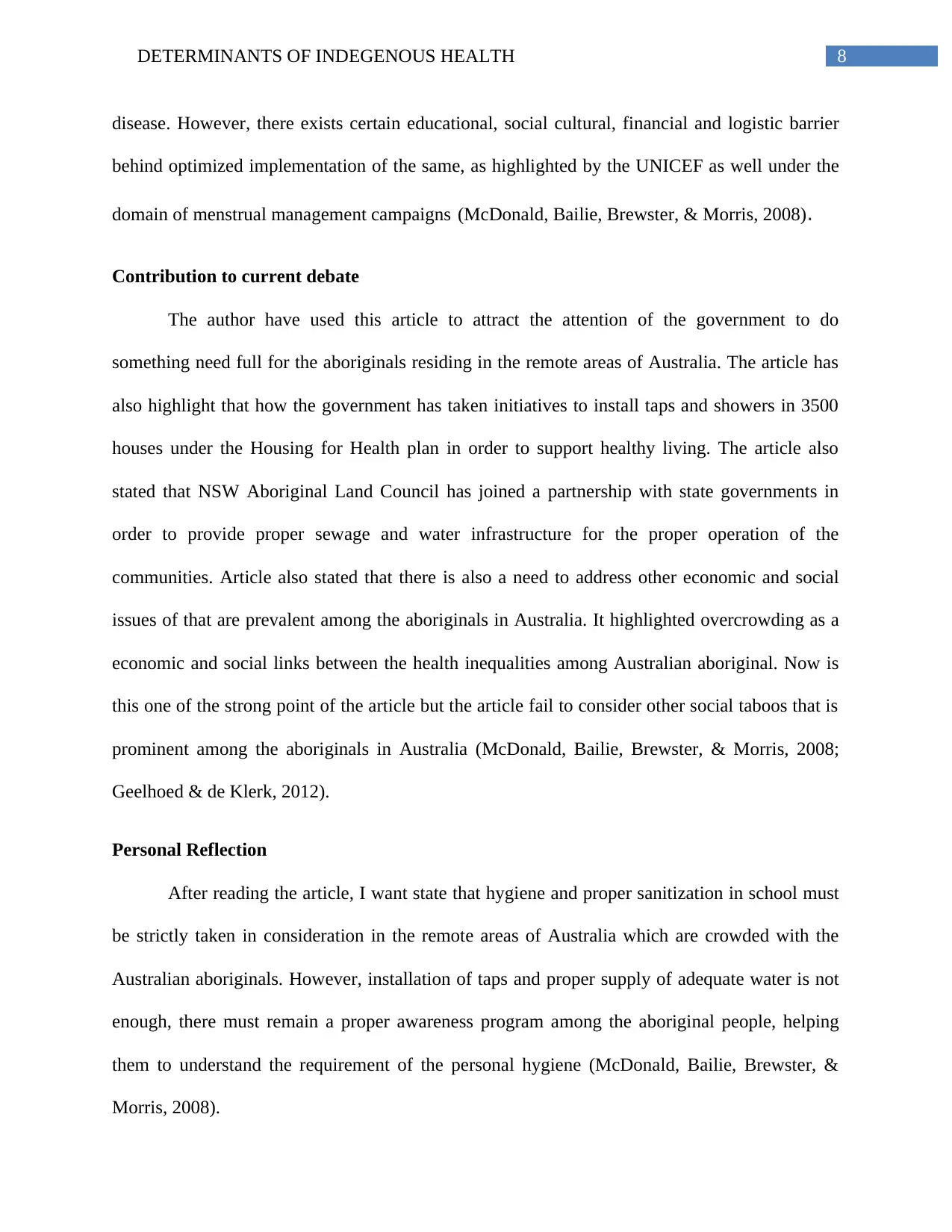
8DETERMINANTS OF INDEGENOUS HEALTH
disease. However, there exists certain educational, social cultural, financial and logistic barrier
behind optimized implementation of the same, as highlighted by the UNICEF as well under the
domain of menstrual management campaigns (McDonald, Bailie, Brewster, & Morris, 2008).
Contribution to current debate
The author have used this article to attract the attention of the government to do
something need full for the aboriginals residing in the remote areas of Australia. The article has
also highlight that how the government has taken initiatives to install taps and showers in 3500
houses under the Housing for Health plan in order to support healthy living. The article also
stated that NSW Aboriginal Land Council has joined a partnership with state governments in
order to provide proper sewage and water infrastructure for the proper operation of the
communities. Article also stated that there is also a need to address other economic and social
issues of that are prevalent among the aboriginals in Australia. It highlighted overcrowding as a
economic and social links between the health inequalities among Australian aboriginal. Now is
this one of the strong point of the article but the article fail to consider other social taboos that is
prominent among the aboriginals in Australia (McDonald, Bailie, Brewster, & Morris, 2008;
Geelhoed & de Klerk, 2012).
Personal Reflection
After reading the article, I want state that hygiene and proper sanitization in school must
be strictly taken in consideration in the remote areas of Australia which are crowded with the
Australian aboriginals. However, installation of taps and proper supply of adequate water is not
enough, there must remain a proper awareness program among the aboriginal people, helping
them to understand the requirement of the personal hygiene (McDonald, Bailie, Brewster, &
Morris, 2008).
disease. However, there exists certain educational, social cultural, financial and logistic barrier
behind optimized implementation of the same, as highlighted by the UNICEF as well under the
domain of menstrual management campaigns (McDonald, Bailie, Brewster, & Morris, 2008).
Contribution to current debate
The author have used this article to attract the attention of the government to do
something need full for the aboriginals residing in the remote areas of Australia. The article has
also highlight that how the government has taken initiatives to install taps and showers in 3500
houses under the Housing for Health plan in order to support healthy living. The article also
stated that NSW Aboriginal Land Council has joined a partnership with state governments in
order to provide proper sewage and water infrastructure for the proper operation of the
communities. Article also stated that there is also a need to address other economic and social
issues of that are prevalent among the aboriginals in Australia. It highlighted overcrowding as a
economic and social links between the health inequalities among Australian aboriginal. Now is
this one of the strong point of the article but the article fail to consider other social taboos that is
prominent among the aboriginals in Australia (McDonald, Bailie, Brewster, & Morris, 2008;
Geelhoed & de Klerk, 2012).
Personal Reflection
After reading the article, I want state that hygiene and proper sanitization in school must
be strictly taken in consideration in the remote areas of Australia which are crowded with the
Australian aboriginals. However, installation of taps and proper supply of adequate water is not
enough, there must remain a proper awareness program among the aboriginal people, helping
them to understand the requirement of the personal hygiene (McDonald, Bailie, Brewster, &
Morris, 2008).
⊘ This is a preview!⊘
Do you want full access?
Subscribe today to unlock all pages.

Trusted by 1+ million students worldwide

9DETERMINANTS OF INDEGENOUS HEALTH
Media article 4
'Close the Gap': indigenous urged to quit smoking
http://www.abc.net.au/local/photos/2012/03/27/3464866.htm
Key issue
Aboriginal smoking is a serious health problem. And from the history of being paid with
Tobacco, the rate of smoking in the aboriginal communities has increased from 40 to 80% (Hoy
et al., 2012). It has been reported that the aboriginals smoke at the time of pregnancy which can
be detrimental for both mother and the child. The rate of smoking had also increased among the
teenagers to a considerable extent.
This article focuses on the number of services that had been provided by the government
in order to achieve good health and increase the life expectancy in the aboriginals and the Torres
Strait Islanders. The occurrence of the chronic diseases like heart diseases and diabetes among
the non indigenous has lead to the formation of the “Close gap campaign” in 2006. The
campaign aimed at focusing on controlling the dependency of the aboriginal to drugs, smoking
and alcohol, provision of opportunities for the tertiary studies. They have organized activities
like spear making and tree plantation. The Pangula Mannamurna Chief Executive Officer, Karen
Glover, had said that during the organization of the campaign it was difficult for them to break
the fear and the hesitation of the aboriginals in approaching their team.
As Pangula said that there were significant gaps and it was difficult to get gentlemen to their
camp that often weren’t looking after their health.
Media article 4
'Close the Gap': indigenous urged to quit smoking
http://www.abc.net.au/local/photos/2012/03/27/3464866.htm
Key issue
Aboriginal smoking is a serious health problem. And from the history of being paid with
Tobacco, the rate of smoking in the aboriginal communities has increased from 40 to 80% (Hoy
et al., 2012). It has been reported that the aboriginals smoke at the time of pregnancy which can
be detrimental for both mother and the child. The rate of smoking had also increased among the
teenagers to a considerable extent.
This article focuses on the number of services that had been provided by the government
in order to achieve good health and increase the life expectancy in the aboriginals and the Torres
Strait Islanders. The occurrence of the chronic diseases like heart diseases and diabetes among
the non indigenous has lead to the formation of the “Close gap campaign” in 2006. The
campaign aimed at focusing on controlling the dependency of the aboriginal to drugs, smoking
and alcohol, provision of opportunities for the tertiary studies. They have organized activities
like spear making and tree plantation. The Pangula Mannamurna Chief Executive Officer, Karen
Glover, had said that during the organization of the campaign it was difficult for them to break
the fear and the hesitation of the aboriginals in approaching their team.
As Pangula said that there were significant gaps and it was difficult to get gentlemen to their
camp that often weren’t looking after their health.
Paraphrase This Document
Need a fresh take? Get an instant paraphrase of this document with our AI Paraphraser
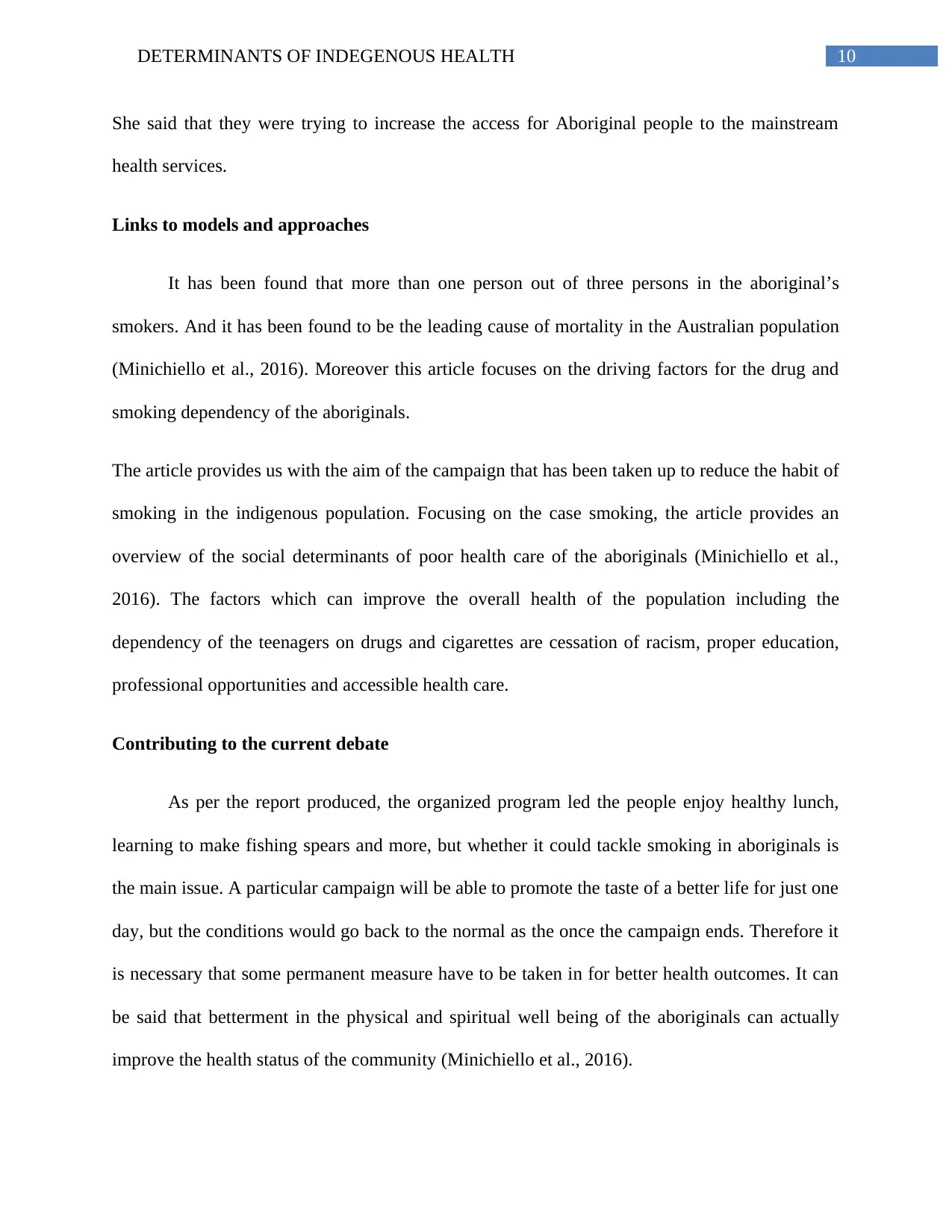
10DETERMINANTS OF INDEGENOUS HEALTH
She said that they were trying to increase the access for Aboriginal people to the mainstream
health services.
Links to models and approaches
It has been found that more than one person out of three persons in the aboriginal’s
smokers. And it has been found to be the leading cause of mortality in the Australian population
(Minichiello et al., 2016). Moreover this article focuses on the driving factors for the drug and
smoking dependency of the aboriginals.
The article provides us with the aim of the campaign that has been taken up to reduce the habit of
smoking in the indigenous population. Focusing on the case smoking, the article provides an
overview of the social determinants of poor health care of the aboriginals (Minichiello et al.,
2016). The factors which can improve the overall health of the population including the
dependency of the teenagers on drugs and cigarettes are cessation of racism, proper education,
professional opportunities and accessible health care.
Contributing to the current debate
As per the report produced, the organized program led the people enjoy healthy lunch,
learning to make fishing spears and more, but whether it could tackle smoking in aboriginals is
the main issue. A particular campaign will be able to promote the taste of a better life for just one
day, but the conditions would go back to the normal as the once the campaign ends. Therefore it
is necessary that some permanent measure have to be taken in for better health outcomes. It can
be said that betterment in the physical and spiritual well being of the aboriginals can actually
improve the health status of the community (Minichiello et al., 2016).
She said that they were trying to increase the access for Aboriginal people to the mainstream
health services.
Links to models and approaches
It has been found that more than one person out of three persons in the aboriginal’s
smokers. And it has been found to be the leading cause of mortality in the Australian population
(Minichiello et al., 2016). Moreover this article focuses on the driving factors for the drug and
smoking dependency of the aboriginals.
The article provides us with the aim of the campaign that has been taken up to reduce the habit of
smoking in the indigenous population. Focusing on the case smoking, the article provides an
overview of the social determinants of poor health care of the aboriginals (Minichiello et al.,
2016). The factors which can improve the overall health of the population including the
dependency of the teenagers on drugs and cigarettes are cessation of racism, proper education,
professional opportunities and accessible health care.
Contributing to the current debate
As per the report produced, the organized program led the people enjoy healthy lunch,
learning to make fishing spears and more, but whether it could tackle smoking in aboriginals is
the main issue. A particular campaign will be able to promote the taste of a better life for just one
day, but the conditions would go back to the normal as the once the campaign ends. Therefore it
is necessary that some permanent measure have to be taken in for better health outcomes. It can
be said that betterment in the physical and spiritual well being of the aboriginals can actually
improve the health status of the community (Minichiello et al., 2016).
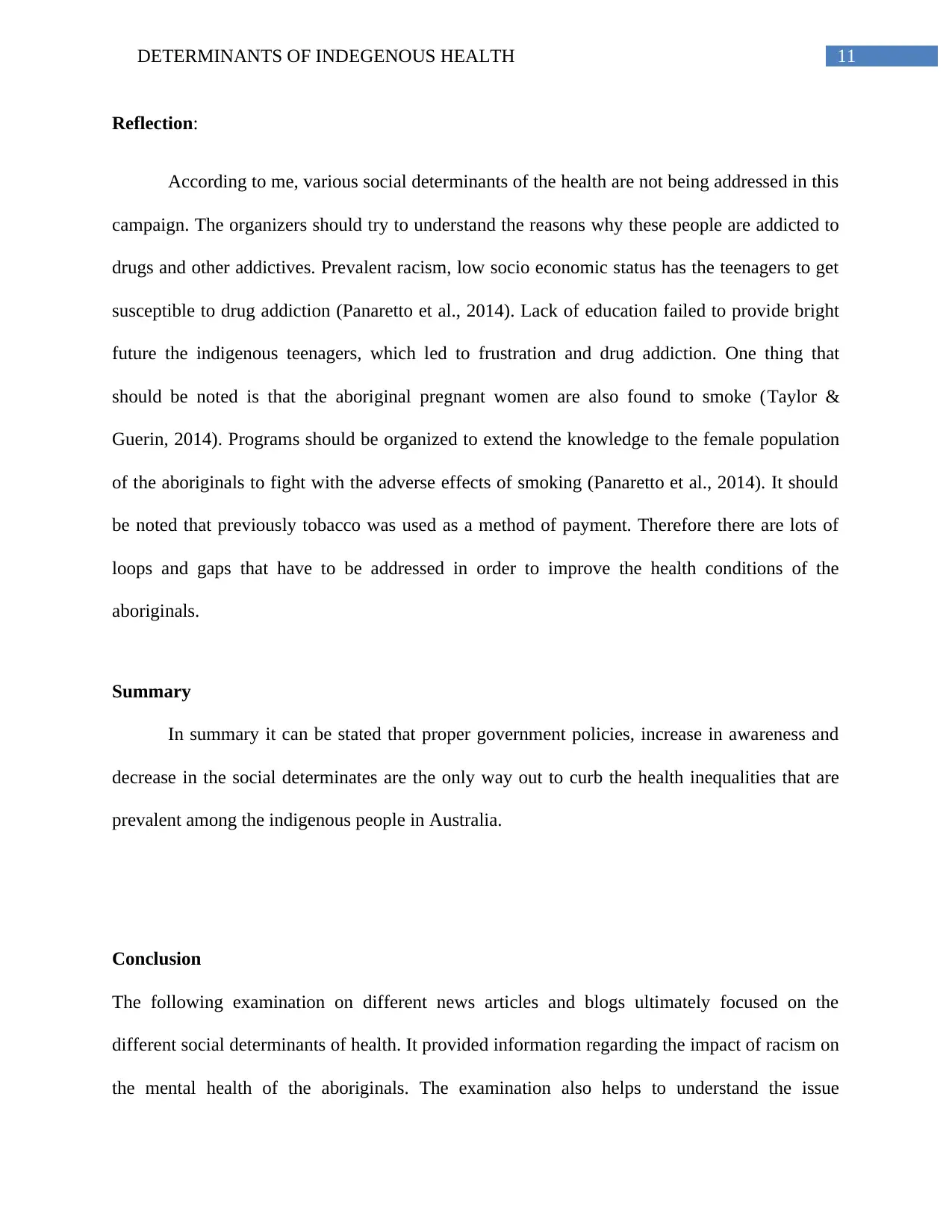
11DETERMINANTS OF INDEGENOUS HEALTH
Reflection:
According to me, various social determinants of the health are not being addressed in this
campaign. The organizers should try to understand the reasons why these people are addicted to
drugs and other addictives. Prevalent racism, low socio economic status has the teenagers to get
susceptible to drug addiction (Panaretto et al., 2014). Lack of education failed to provide bright
future the indigenous teenagers, which led to frustration and drug addiction. One thing that
should be noted is that the aboriginal pregnant women are also found to smoke (Taylor &
Guerin, 2014). Programs should be organized to extend the knowledge to the female population
of the aboriginals to fight with the adverse effects of smoking (Panaretto et al., 2014). It should
be noted that previously tobacco was used as a method of payment. Therefore there are lots of
loops and gaps that have to be addressed in order to improve the health conditions of the
aboriginals.
Summary
In summary it can be stated that proper government policies, increase in awareness and
decrease in the social determinates are the only way out to curb the health inequalities that are
prevalent among the indigenous people in Australia.
Conclusion
The following examination on different news articles and blogs ultimately focused on the
different social determinants of health. It provided information regarding the impact of racism on
the mental health of the aboriginals. The examination also helps to understand the issue
Reflection:
According to me, various social determinants of the health are not being addressed in this
campaign. The organizers should try to understand the reasons why these people are addicted to
drugs and other addictives. Prevalent racism, low socio economic status has the teenagers to get
susceptible to drug addiction (Panaretto et al., 2014). Lack of education failed to provide bright
future the indigenous teenagers, which led to frustration and drug addiction. One thing that
should be noted is that the aboriginal pregnant women are also found to smoke (Taylor &
Guerin, 2014). Programs should be organized to extend the knowledge to the female population
of the aboriginals to fight with the adverse effects of smoking (Panaretto et al., 2014). It should
be noted that previously tobacco was used as a method of payment. Therefore there are lots of
loops and gaps that have to be addressed in order to improve the health conditions of the
aboriginals.
Summary
In summary it can be stated that proper government policies, increase in awareness and
decrease in the social determinates are the only way out to curb the health inequalities that are
prevalent among the indigenous people in Australia.
Conclusion
The following examination on different news articles and blogs ultimately focused on the
different social determinants of health. It provided information regarding the impact of racism on
the mental health of the aboriginals. The examination also helps to understand the issue
⊘ This is a preview!⊘
Do you want full access?
Subscribe today to unlock all pages.

Trusted by 1+ million students worldwide
1 out of 15
Related Documents
Your All-in-One AI-Powered Toolkit for Academic Success.
+13062052269
info@desklib.com
Available 24*7 on WhatsApp / Email
![[object Object]](/_next/static/media/star-bottom.7253800d.svg)
Unlock your academic potential
Copyright © 2020–2025 A2Z Services. All Rights Reserved. Developed and managed by ZUCOL.





